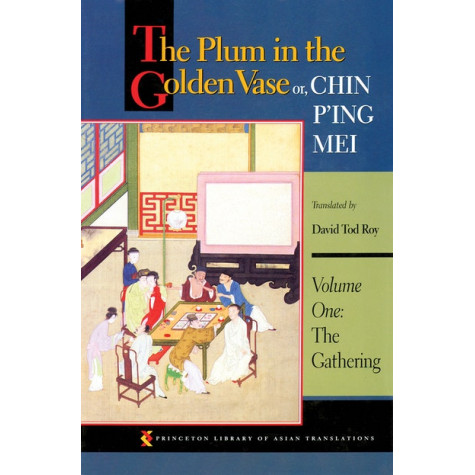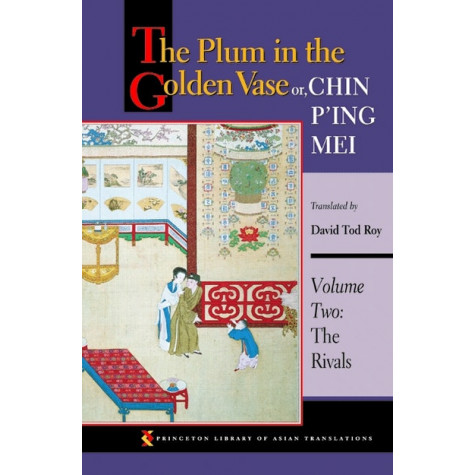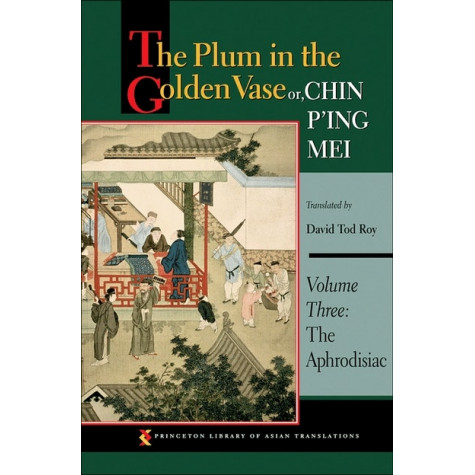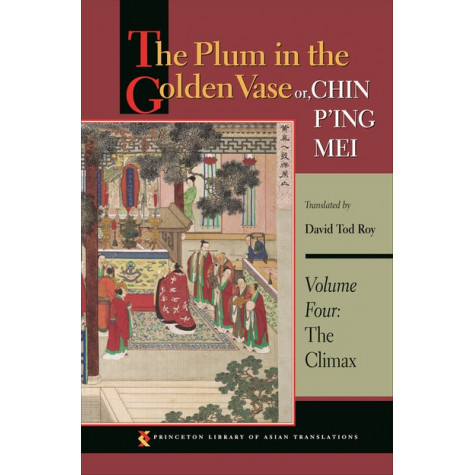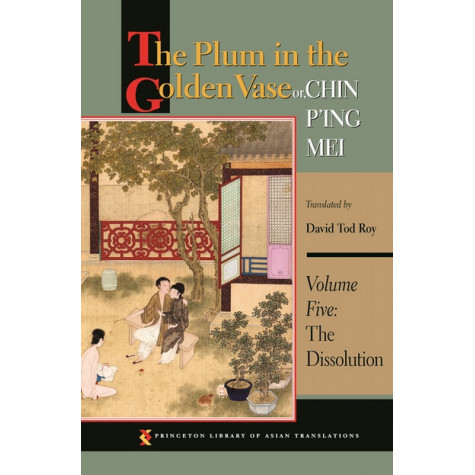The Plum in the Golden Vase or, Chin P'ing Mei, 5 Volumes SET
- Author:
- Pages: Total - 3672
- Year: 1997, 2006, 2011, 2015, 2015
- Book Code: Paperback
- Availability: In Stock
- Publisher: Princeton University Press
-
₹18,495.00
The Plum in the Golden Vase or, Chin P'ing Mei, 5 Volumes SET
- Volume1: The Gathering 9780691016146 - Pages: 520, 1997
- Volume2: The Rivals 9780691126197 - Pages: 720, 2006
- Volume3: The Aphrodisiac 9780691150185 - Pages: 776, 2011
- Volume4: The Climax 9780691169828 - Pages: 1032, 2015
- Volume5: The Dissolution 9780691169835 - Pages: 624, 2015
--------------------------------------------
About the Author
David Tod Roy (1933–2016) was professor emeritus of Chinese literature at the University of Chicago. His monumental five-volume translation of the Chin P'ing Mei was completed in 2013.,
--------------------------------------------
With the possible exception of The Tale of Genji (1010) and Don Quixote (1615), there is no earlier work of prose fiction of equal sophistication in world literature. Although its importance in the history of Chinese narrative has long been recognized, the technical virtuosity of the author, which is more reminiscent of the Dickens of Bleak House, the Joyce of Ulysses, or the Nabokov of Lolita than anything in the earlier Chinese fiction tradition, has not yet received adequate recognition. This is partly because all of the existing European translations are either abridged or based on an inferior recension of the text. This translation and its annotation aim to faithfully represent and elucidate all the rhetorical features of the original in its most authentic form and thereby enable the Western reader to appreciate this Chinese masterpiece at its true worth.
Volume1: The Gathering
This is the first volume in David Roy’s celebrated translation of one of the most famous and important novels in Chinese literature. The Plum in the Golden Vase or, Chin P’ing Mei is an anonymous sixteenth-century work that focuses on the domestic life of Hsi-men Ch’ing, a corrupt, upwardly mobile merchant in a provincial town, who maintains a harem of six wives and concubines. The novel, known primarily for its erotic realism, is also a landmark in the development of the narrative art form—not only from a specifically Chinese perspective but in a world-historical context.
Review
[A] book of manners for the debauched. Its readers in the late Ming period likely hid it under their bedcovers."
—Amy Tan, New York Times Book Review
"[I]t is time to remind ourselves that The Plum in the Golden Vase is not just about sex, whether the numerous descriptions of sexual acts throughout the novel be viewed as titillating, harshly realistic, or, in Mr. Roy's words, intended 'to express in the most powerful metaphor available to him the author's contempt for the sort of persons who indulge in them.' The novel is a sprawling panorama of life and times in urban China, allegedly set safely in the Sung dynasty, but transparently contemporary to the author's late sixteenth-century world, as scores of internal references demonstrate. The eight hundred or so men, women, and children who appear in the book cover a breath-taking variety of human types, and encompass pretty much every imaginable mood and genre—from sadism to tenderness, from light humor to philosophical musings, from acute social commentary to outrageous satire."
—Jonathan Spence, New York Review of Books
"David Tod Roy enters with zest into the spirit and the letter of the original, quite surpassing ... other earlier versions."
—Paul St. John Mackintosh, Literary Review
"Reading Roy's translation is a remarkable experience."
—Robert Chatain, Chicago Tribune Review of Books
"What Roy has already accomplished [in this volume] is enough to establish his translation as definitive. . . . A tremendous achievement."
—Charles Horner, Commentary
"This is the first complete English translation of world literature and will immediately supersede all existing partial and abridged translations in that language. Even aside from the stunning achievement of the translation itself, the book represents a lifetime of meticulous scholarship on an enormous number of Sinological subjects. This work is the culmination of David Roy's entire scholarly career and a compendium of his vast learning in all phases of traditional Chinese civilization."—Andrew Plaks, Princeton University
Volume2: The Rivals
This is the second volume in David Roy’s celebrated translation of one of the most famous and important novels in Chinese literature. The Plum in the Golden Vase or, Chin P’ing Mei is an anonymous sixteenth-century work that focuses on the domestic life of Hsi-men Ch’ing, a corrupt, upwardly mobile merchant in a provincial town, who maintains a harem of six wives and concubines. The novel, known primarily for its erotic realism, is also a landmark in the development of the narrative art form—not only from a specifically Chinese perspective but in a world-historical context.
Review
"[A] book of manners for the debauched. Its readers in the late Ming period likely hid it under their bedcovers."
—Amy Tan, New York Times Book Review
"[I]t is time to remind ourselves that The Plum in the Golden Vase is not just about sex, whether the numerous descriptions of sexual acts throughout the novel be viewed as titillating, harshly realistic, or, in Mr. Roy's words, intended 'to express in the most powerful metaphor available to him the author's contempt for the sort of persons who indulge in them.' The novel is a sprawling panorama of life and times in urban China, allegedly set safely in the Sung dynasty, but transparently contemporary to the author's late sixteenth-century world, as scores of internal references demonstrate. The eight hundred or so men, women, and children who appear in the book cover a breath-taking variety of human types, and encompass pretty much every imaginable mood and genre—from sadism to tenderness, from light humor to philosophical musings, from acute social commentary to outrageous satire."
—Jonathan Spence, New York Review of Books
"Racy, colloquial, and robustly scatalogical, [this translation] could only have been done now, when our literary language has finally shed its Victorian values. David Tod Roy enters with zest into the spirit and the letter of the original, quite surpassing . . . earlier versions."
—Paul St. John Mackintosh, Literary Review
"Reading Roy's translation is a remarkable experience."
—Robert Chatain, Chicago Tribune Review of Books
Volume3: The Aphrodisiac
This is the third volume in David Roy’s celebrated translation of one of the most famous and important novels in Chinese literature. The Plum in the Golden Vase or, Chin P’ing Mei is an anonymous sixteenth-century work that focuses on the domestic life of Hsi-men Ch’ing, a corrupt, upwardly mobile merchant in a provincial town, who maintains a harem of six wives and concubines. The novel, known primarily for its erotic realism, is also a landmark in the development of the narrative art form—not only from a specifically Chinese perspective but in a world-historical context.
Written during the second half of the sixteenth century and first published in 1618, The Plum in the Golden Vase is noted for its surprisingly modern technique. With the possible exception of The Tale of Genji (ca. 1010) and Don Quixote (1605, 1615), there is no earlier work of prose fiction of equal sophistication in world literature. Although its importance in the history of Chinese narrative has long been recognized, the technical virtuosity of the author, which is more reminiscent of the Dickens of Bleak House, the Joyce of Ulysses, or the Nabokov of Lolita than anything in earlier Chinese fiction, has not yet received adequate recognition. This is partly because all of the existing European translations are either abridged or based on an inferior recension of the text. This translation and its annotation aim to faithfully represent and elucidate all the rhetorical features of the original in its most authentic form and thereby enable the Western reader to appreciate this Chinese masterpiece at its true worth.
Replete with convincing portrayals of the darker side of human nature, it should appeal to anyone interested in a compelling story, compellingly told.
Review
"[A] book of manners for the debauched. Its readers in the late Ming period likely hid it under their bedcovers."
—Amy Tan, New York Times Book Review
"[I]t is time to remind ourselves that The Plum in the Golden Vase is not just about sex, whether the numerous descriptions of sexual acts throughout the novel be viewed as titillating, harshly realistic, or, in Mr. Roy's words, intended 'to express in the most powerful metaphor available to him the author's contempt for the sort of persons who indulge in them.' The novel is a sprawling panorama of life and times in urban China, allegedly set safely in the Sung dynasty, but transparently contemporary to the author's late sixteenth-century world, as scores of internal references demonstrate. The eight hundred or so men, women, and children who appear in the book cover a breath-taking variety of human types, and encompass pretty much every imaginable mood and genre—from sadism to tenderness, from light humor to philosophical musings, from acute social commentary to outrageous satire."
—Jonathan Spence, New York Review of Books
"Clearly David Roy is the greatest scholar-translator in the field of premodern vernacular Chinese fiction. . . . The puns and various other kinds of word plays that abound in the Chin P'ing Mei are so difficult to translate that I can't help 'slapping the table in amazement' each time I see evidence of Roy's masterful rendition of them. . . . I recommend this book, in the strongest possible terms, to anyone interested in the novel form in general, in Chinese literature in particular, or in the translation of Chinese literature."
—Shuhui Yang, Chinese Literature: Essays, Articles, and Reviews
"Racy, colloquial, and robustly scatalogical, [this translation] could only have been done now, when our literary language has finally shed its Victorian values. David Tod Roy enters with zest into the spirit and the letter of the original, quite surpassing . . . earlier versions."
—Paul St. John Mackintosh, Literary Review
"Reading Roy's translation is a remarkable experience."
—Robert Chatain, Chicago Tribune Review of Books
"[B]y virtue of both Roy's decision to translate the cihua version of the novel, and his manner of doing so, we have here an invaluable insight into the material and popular literary world of the late-Ming that will serve as a wonderful resource for students of the various aspects of this fascinating and rapidly changing period of late imperial Chinese history for many years to come."
—Duncan Campbell, New Zealand Journal of Asian Studies
"Generations of readers will be grateful for Roy's monumental translation of the Chin P'ing Mei. The capstone in a distinguished career, this translation is a heroic and magnanimous act of scholarship. The encyclopedic annotation, which sets standards seldom matched by translation from any language, will be indispensable not only to the general reader but to scholars of this work."—Sophie Volpp, University of California, Berkeley
"In Volume Three of David Tod Roy's magnificent translation, corruption is in full swing in the world of Chin P'ing Mei. Roy brings to vivid life the clamoring voices of courtesans, wives, hangers-on, and officials, and, as no previous translator has done, he shows how the narrative weaves together literary genres from doggerel couplets to palace edicts. Roy's is the first translation in which Western readers can experience the full impact of this monumental novel."—Katherine Carlitz, University of Pittsburgh
Volume4: The Climax
This is the fourth and penultimate volume in David Roy’s celebrated translation of one of the most famous and important novels in Chinese literature. The Plum in the Golden Vase or, Chin P’ing Mei is an anonymous sixteenth-century work that focuses on the domestic life of Hsi-men Ch’ing, a corrupt, upwardly mobile merchant in a provincial town, who maintains a harem of six wives and concubines. The novel, known primarily for its erotic realism, is also a landmark in the development of the narrative art form—not only from a specifically Chinese perspective but in a world-historical context.
This complete and annotated translation aims to faithfully represent and elucidate all the rhetorical features of the original in its most authentic form and thereby enable the Western reader to appreciate this Chinese masterpiece at its true worth.
Review
"[A] book of manners for the debauched. Its readers in the late Ming period likely hid it under their bedcovers."
—Amy Tan, New York Times Book Review
"[I]t is time to remind ourselves that The Plum in the Golden Vase is not just about sex, whether the numerous descriptions of sexual acts throughout the novel be viewed as titillating, harshly realistic, or, in Mr. Roy's words, intended 'to express in the most powerful metaphor available to him the author's contempt for the sort of persons who indulge in them.' The novel is a sprawling panorama of life and times in urban China, allegedly set safely in the Sung dynasty, but transparently contemporary to the author's late sixteenth-century world, as scores of internal references demonstrate. The eight hundred or so men, women, and children who appear in the book cover a breath-taking variety of human types, and encompass pretty much every imaginable mood and genre—from sadism to tenderness, from light humor to philosophical musings, from acute social commentary to outrageous satire."
—Jonathan Spence, New York Review of Books
"Reading Roy's translation is a remarkable experience."
—Robert Chatain, Chicago Tribune Review of Books
"Both the fourth volume of The Plum and the previous three volumes are top-notch English translation of traditional Chinese fiction. Roy's superb translation skills preserve the subtleties in the original Chinese novel. English-speaking readers can, for the first time, appreciate one of the masterpieces of Chinese fiction in its entirety, thanks to Roy's diligent and careful work. Most important of all, The Plum represents the culmination of Roy's life-long devotion to research on fin Ping Mei and demonstrates Roy's encyclopedic knowledge of Jin Ping Mei scholarship. Reading The Plum can help scholars understand the research that has been conducted on this novel and help them develop new directions for future research. I wholeheartedly recommend The Plum to anyone interested in Chinese literature, culture, and history, and look forward to the publication of the final volume of Roy's translation."
—Junjie Luo, Chinese Literature
"This volume, a masterwork of translation of language, culture, social values, and literary intent provides students of linguistics, philosophy, psychology, anthropology, sociology, economics, and history, as well as those willing to invest time in a long but highly entertaining tale with an invaluable opportunity to gain insight into sixteenth-century society outside imperial court circles during the Ming era."
—Ilicia J. Sprey, Sixteenth Century Journal
"Clearly David Roy is the greatest scholar-translator in the field of premodern vernacular Chinese fiction. . . . The puns and various other kinds of word plays that abound in the Chin P'ing Mei are so difficult to translate that I can't help 'slapping the table in amazement' each time I see evidence of Roy's masterful rendition of them. . . . I recommend this book, in the strongest possible terms, to anyone interested in the novel form in general, in Chinese literature in particular, or in the translation of Chinese literature."
—Shuhui Yang, Chinese Literature
Volume5: The Dissolution
This is the fifth and final volume in David Roy’s celebrated translation of one of the most famous and important novels in Chinese literature. The Plum in the Golden Vase or, Chin P’ing Mei is an anonymous sixteenth-century work that focuses on the domestic life of Hsi-men Ch’ing, a corrupt, upwardly mobile merchant in a provincial town, who maintains a harem of six wives and concubines. The novel, known primarily for its erotic realism, is also a landmark in the development of the narrative art form—not only from a specifically Chinese perspective but in a world-historical context.
This complete and annotated translation aims to faithfully represent and elucidate all the rhetorical features of the original in its most authentic form and thereby enable the Western reader to appreciate this Chinese masterpiece at its true worth.
Review
"The story sprawls. There are more than eight hundred named characters, from high officials and military commanders to peddlers and prostitutes, with actors, tailors, monks and nuns, fortunetellers, acrobats, and many others, even cats and dogs, in between. Roy helps us keep track of everyone in a fifty-six-page 'cast of characters.'. . . In the original woodblock printing of the text, characters follow one another, without punctuation, no matter their source. Modern printings provide punctuation, but Roy goes further by devising a system of indentation and differing type sizes to set off allusions, poems, and songs. With this editorial help, the translation is actually easier to read than the original."
—Perry Link, New York Review of Books
"David Tod Roy, after more [than] 20 years of work, completed the fifth volume of his translation of the Chin Ping Mei, entitled The Plum in the Golden Vase. It's a masterpiece [and] an epic scholarly achievement. . . . The world of the Chin Ping Mei is beautiful and dark, cheap and exalted, righteous and profane, gorgeous and lurid and stinking and glorious."
—Stephen Marche, Los Angeles Review of Books
"Roy's complete translation makes it possible for English readers everywhere to read and appreciate this work, one of the great, sophisticated masterpieces of world literature."
—Choice
"Roy's translation . . . is both more complete and more readable than previous English translations. . . . Roy's rendering deftly switches between registers along with the novel, carrying across both its refined language and its infamous vulgarities."
—Scott W. Gregory, Ming Studies
"One can only begin to appreciate the work that has gone into this volume, with its numerous pages of notes, bibliography and index, and to the five volumes as a whole. . . . We are indebted to Professor Roy. The novel is a masterwork of Chinese fiction, and we celebrate the completion of his translation."
—Andrew Lo, Bulletin of the School of Oriental and African Studies
"The immensity of David Tod Roy's achievement in the eld of literary translation can hardly be overstated. . . . We are all . . . tremendously indebted to Roy’s erudition and his indefatigable work of defamiliarization. No one can ever look at a proverb with the same complacency after reading Roy’s translation."
—Maria Franca Sibau, Journal of the American Oriental Society
"Praise for the previous volume: "[A] book of manners for the debauched. Its readers in the late Ming period likely hid it under their bedcovers.""
—Amy Tan, New York Times Book Review
Tags: The Plum in the Golden Vase or, Chin P'ing Mei, The Gathering, The Rivals, The Aphrodisiac, The Climax, The Dissolution, 9780691016146, 9780691126197, 9780691150185, 9780691169828, 9780691169835, David Tod Roy, Princeton University Press

